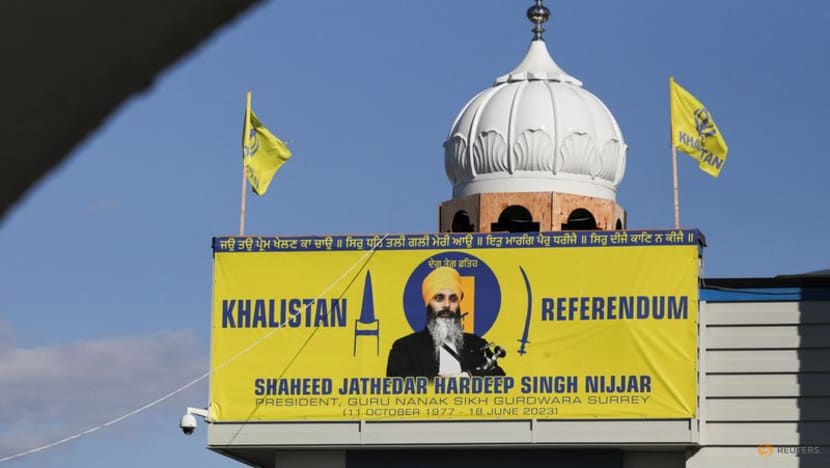Indian governments past and present only have themselves to blame for tensions, renewed by a separatist leader’s murder in Canada, says Karishma Vaswani for Bloomberg Opinion.

SINGAPORE: It’s the separatist movement most people have never heard of, but it is at the heart of the very public India-Canada spat ignited by Prime Minister Justin Trudeau’s allegations that India is behind the assassination of a Sikh activist in British Colombia – charges New Delhi firmly denies.
Behind the rhetoric, though, is a desire for Sikh nationhood. And that’s why India is so worried.
Khalistan, as campaigners call this proposed independent homeland, is a crisis of India’s own making. Successive governments have neglected, manipulated and exploited the state of Punjab – traditionally seen as India’s breadbasket – and the Sikhs who inhabit it for their own political and economic gain.
That, in turn, has led to a brewing resentment among the community both in and outside India that could revive a mostly dormant domestic independence movement, transforming it into another flashpoint like Kashmir or Manipur in the northeast.
But a separate state won’t solve the myriad of issues facing Punjab, where most of India’s Sikhs live. Unemployment, a crippling drug crisis, high rates of female infanticide are just some of the problems.
A SEPARATE STATE WON’T SOLVE SIKHS’ PROBLEMS
India’s governments – past and present – have failed to offer them a sense of identity or inclusion. Improving governance and investing properly in Punjab will help, but religious and ethnic minorities under Prime Minister Narendra Modi’s increasingly hardline Hindu nationalist administration also need to be better protected.
Numbering 23 million, Sikhs make up just under 2 per cent of India’s population but play an outsized role in the economy and socio-cultural life.
Their faith is one of the nation’s youngest. Born as a reform movement in the 1500s aimed at shedding parts of Hinduism and Islam, Sikhism takes liberally from both. Beliefs like karma and reincarnation come from Hinduism, while the lack of a physical form represented as the divine, from Islam.
They deliberately have physical characteristics that make them stand out in a crowd – observant men and women never cut their hair, male Sikhs and sometimes females wear turbans, and sport an iron bracelet on their wrists. Men are given the last name Singh, which means lion and women Kaur, which means princess.
After India’s independence from Britain in 1947, Punjab and its mostly Sikh farmers helped a food insecure nation take steps toward self-sufficiency.
But the community has always felt misunderstood and unrewarded for their contributions, says Pritam Singh, an academic visitor at the Oxford School of Global and Area Studies with the University of Oxford. He notes that Sikhs who question the status quo are unfairly labelled as separatists by the mainstream Indian media, “so there’s a constant tension between Punjab and the Indian state”.
DIASPORA AMONG THE MOST VOCAL SUPPORTERS OF SIKH INDEPENDENCE
This is not new. Some Sikhs say they should have been given their own homeland at the time of India’s independence. But the movement for a separate state – a land of the pure, as the word Khalistan means – reached its peak in the 1980s and 1990s.
That’s when the insurgency spilled over into other parts of India, mainly the capital New Delhi. Punjab saw a steady stream of violent attacks, thousands of deaths and two horrific moments in Indian history: The Indian army’s storming of the Golden Temple, the holiest of all shrines for Sikhs, and the subsequent assassination, an act of revenge, of then prime minister Indira Gandhi by her Sikh bodyguards.
Both events saw large numbers of Sikhs killed. Official records say around 2,000 people died; other estimates put it much higher. Many Sikhs feel their grievances have never properly been addressed.
Fleeing the violence, many migrated to places like the United Kingdom, United States and Canada, which has the largest population of Sikhs outside India and the most active separatist movement. They left behind their homeland but took with them the memories of their fear and anger – and passed that down to the younger generation who are now some of the most vocal supporters of independence today.
In India, the desire for a separate nation is much smaller, but even so, of great concern to the authorities who have outlawed the movement and view it as a terrorist threat.
New Delhi points to the 1985 bombing of Air India flight 182, which killed 329 people, as an example of this. It originated from Canada and was widely believed to have been carried out by Canadian-based Sikhs retaliating against the Indian state.


